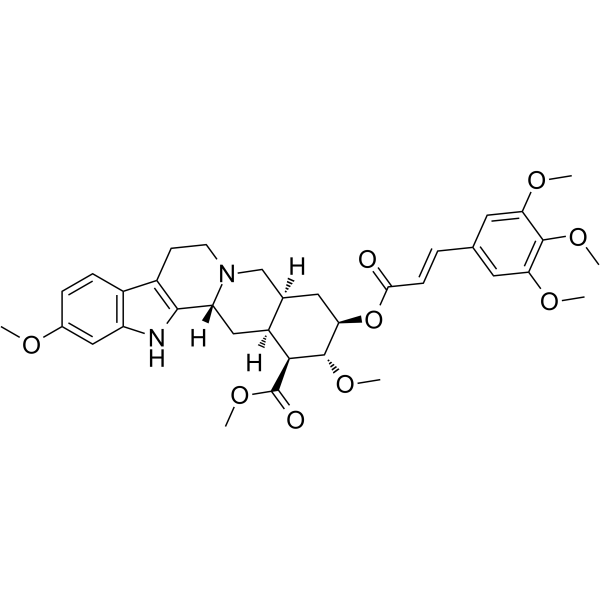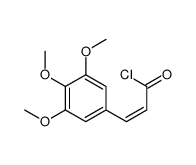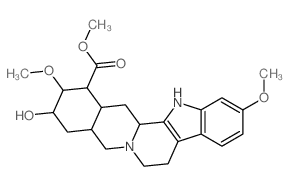24815-24-5
| 中文名 | 利血那明 |
|---|---|
| 英文名 | rescinnamine |
| 中文别名 | 利血胺 |
| 英文别名 |
Rozex
RESCINNAMINE Anapral reserpinine Moderil Tuareg Resipal Rescin Apolon Cartric Apoterin ANAPREL |
| 描述 | 胺是吲哚生物碱利血平的衍生物。胺具有镇静作用。胺可用于高血压研究[1][2]。 |
|---|---|
| 相关类别 | |
| 参考文献 |
| 密度 | 1.31g/cm3 |
|---|---|
| 沸点 | 756.8ºC at 760 mmHg |
| 熔点 | 238ºC |
| 分子式 | C35H42N2O9 |
| 分子量 | 634.71600 |
| 闪点 | 411.5ºC |
| 精确质量 | 634.28900 |
| PSA | 117.78000 |
| LogP | 4.50860 |
| 外观性状 | 白色至奶油色粉末 |
| 蒸汽压 | 8.5E-23mmHg at 25°C |
| 折射率 | 1.621 |
| 储存条件 | 2-8°C, 密封, 干燥, 避光 |
| 计算化学 | 1.疏水参数计算参考值(XlogP):4.5 2.氢键供体数量:1 3.氢键受体数量:10 4.可旋转化学键数量:11 5.互变异构体数量:无 6.拓扑分子极性表面积:118 7.重原子数量:46 8.表面电荷:0 9.复杂度:1080 10.同位素原子数量:0 11.确定原子立构中心数量:6 12.不确定原子立构中心数量:0 13.确定化学键立构中心数量:1 14.不确定化学键立构中心数量:0 15.共价键单元数量:1 |
Synonym:Methyl reserpate 3,4,5-trimethoxycinnamic acid ester; Methyl 18-O-(3,4,5-trimethoxycinnamoyl) reserpate; Recinnamine; Resepinine (C35 alkaloid); Reserpinine; Trimethoxycinnamoyl methyl reserpate; Trimethoxy cinnamoyl reserpate de methyl; 3,4,5 Section 2 - COMPOSITION, INFORMATION ON INGREDIENTS
Risk Phrases: 20/21/22 Section 3 - HAZARDS IDENTIFICATION EMERGENCY OVERVIEW
Harmful by inhalation, in contact with skin and if swallowed.Light sensitive. Potential Health Effects Eye: May cause eye irritation. Skin: May cause skin irritation. Ingestion: May cause central nervous system depression. May be harmful if swallowed. Inhalation: May cause rhinitis (inflammation of the mucous membrane of the nose). Chronic: Not available. Section 4 - FIRST AID MEASURES Eyes: Flush eyes with plenty of water for at least 15 minutes, occasionally lifting the upper and lower eyelids. Get medical aid immediately. Skin: Get medical aid immediately. Immediately flush skin with plenty of water for at least 15 minutes while removing contaminated clothing and shoes. Remove contaminated clothing and shoes. Ingestion: If victim is conscious and alert, give 2-4 cupfuls of milk or water. Never give anything by mouth to an unconscious person. Get medical aid immediately. Inhalation: Get medical aid immediately. Remove from exposure and move to fresh air immediately. If not breathing, give artificial respiration. If breathing is difficult, give oxygen. Notes to Physician: Treat symptomatically and supportively. Section 5 - FIRE FIGHTING MEASURES General Information: As in any fire, wear a self-contained breathing apparatus in pressure-demand, MSHA/NIOSH (approved or equivalent), and full protective gear. During a fire, irritating and highly toxic gases may be generated by thermal decomposition or combustion. Extinguishing Media: Use agent most appropriate to extinguish fire. Use carbon dioxide, dry chemical powder or water spray. Section 6 - ACCIDENTAL RELEASE MEASURES General Information: Use proper personal protective equipment as indicated in Section 8. Spills/Leaks: Sweep up, then place into a suitable container for disposal. Avoid generating dusty conditions. Provide ventilation. Section 7 - HANDLING and STORAGE Handling: Wash thoroughly after handling. Remove contaminated clothing and wash before reuse. Use with adequate ventilation. Minimize dust generation and accumulation. Avoid contact with eyes, skin, and clothing. Keep container tightly closed. Avoid ingestion and inhalation. Store protected from light. Do not breathe dust or fumes. Storage: Keep container closed when not in use. Store protected from light. Store in a cool, dry area away from incompatible substances. Section 8 - EXPOSURE CONTROLS, PERSONAL PROTECTION Engineering Controls: Facilities storing or utilizing this material should be equipped with an eyewash facility and a safety shower. Use adequate ventilation to keep airborne concentrations low. Exposure Limits CAS# 24815-24-5: Personal Protective Equipment Eyes: Wear appropriate protective eyeglasses or chemical safety goggles as described by OSHA's eye and face protection regulations in 29 CFR 1910.133 or European Standard EN166. Skin: Wear appropriate protective gloves to prevent skin exposure. Clothing: Wear appropriate protective clothing to prevent skin exposure. Respirators: A respiratory protection program that meets OSHA's 29 CFR 1910.134 and ANSI Z88.2 requirements or European Standard EN 149 must be followed whenever workplace conditions warrant respirator use. Section 9 - PHYSICAL AND CHEMICAL PROPERTIES Physical State: Crystalline powder Color: white to cream Odor: odorless pH: Not available. Vapor Pressure: Not available. Viscosity: Not available. Boiling Point: Not available. Freezing/Melting Point: 234.00 - 237.00 deg C Autoignition Temperature: Not applicable. Flash Point: Not applicable. Explosion Limits, lower: Not available. Explosion Limits, upper: Not available. Decomposition Temperature: Not available. Solubility in water: Insoluble. Specific Gravity/Density: Not available. Molecular Formula: C35H42N2O9 Molecular Weight: 634.71 Section 10 - STABILITY AND REACTIVITY Chemical Stability: Stable under normal temperatures and pressures. Darkens on exposure to light. Conditions to Avoid: Incompatible materials, light, strong oxidants. Incompatibilities with Other Materials: Strong oxidizing agents, direct light. Hazardous Decomposition Products: Nitrogen oxides, carbon monoxide, irritating and toxic fumes and gases, carbon dioxide. Hazardous Polymerization: Has not been reported Section 11 - TOXICOLOGICAL INFORMATION RTECS#: CAS# 24815-24-5: ZG0700000 LD50/LC50: CAS# 24815-24-5: Oral, mouse: LD50 = 1420 mg/kg; Oral, rat: LD50 = 1 gm/kg. TDLo: Human = 4ug/kg/D (olfactory effects, general depression, Carcinogenicity: Rescinnamine, N.F. XIII - Not listed by ACGIH, IARC, or NTP. Other: See actual entry in RTECS for complete information. Section 12 - ECOLOGICAL INFORMATION Other No information available. Section 13 - DISPOSAL CONSIDERATIONS Dispose of in a manner consistent with federal, state, and local regulations. Section 14 - TRANSPORT INFORMATION IATA Not regulated as a hazardous material. IMO Not regulated as a hazardous material. RID/ADR Not regulated as a hazardous material. Section 15 - REGULATORY INFORMATION European/International Regulations European Labeling in Accordance with EC Directives Hazard Symbols: XN Risk Phrases: R 20/21/22 Harmful by inhalation, in contact with skin and if swallowed. Safety Phrases: S 24/25 Avoid contact with skin and eyes. WGK (Water Danger/Protection) CAS# 24815-24-5: 1 Canada None of the chemicals in this product are listed on the DSL/NDSL list. CAS# 24815-24-5 is not listed on Canada's Ingredient Disclosure List. US FEDERAL TSCA CAS# 24815-24-5 is not listed on the TSCA inventory. It is for research and development use only. SECTION 16 - ADDITIONAL INFORMATION N/A |
CHEMICAL IDENTIFICATION
HEALTH HAZARD DATAACUTE TOXICITY DATA
|
| 危害码 (欧洲) | Xn |
|---|---|
| 风险声明 (欧洲) | 25-20/21/22 |
| 安全声明 (欧洲) | 22-45-36 |
| 危险品运输编码 | UN 1544 |
| 包装等级 | III |
| 危险类别 | 6.1(b) |
|
~% 
24815-24-5 |
| 文献:US2854454 , ; |
| 上游产品 2 | |
|---|---|
| 下游产品 0 | |



